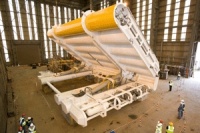What is claimed to be the world’s largest working hydroelectric wave-energy device was launched on 20 November at the European Marine Energy Centre (EMEC) in Orkney.
The device, dubbed Oyster, was developed by wave-energy company Aquamarine Power. It is currently the world’s only hydroelectric wave-energy device that is producing power.
The Oyster launch took place at EMEC’s Billia Croo site near Stromness, where the device was installed this summer.
Oyster is now producing power by pumping high-pressure water to its onshore hydroelectric turbine. This will be fed into the national grid to power homes in Orkney and beyond. It is claimed a farm of 20 Oysters would provide enough energy to power 9,000 three-bedroom family homes.
Speaking at the launch, Scotland’s first minister Alex Salmond MP, MSP, said: ‘Scotland’s potential renewables capacity is estimated to be around 60GW. Our waters hold around 10 per cent of Europe’s wave-power potential and as much as a quarter of its tidal-power potential.’
Salmond also announced further R&D funding of almost £1m to Aquamarine Power for the development of Oyster 2, which could be installed within two years.
He said: ‘Through our investments and initiatives such as the Saltire Prize, the Scottish government is working to ensure we capitalise on our rich natural resources, to meet our ambitious climate-change targets, to create more high-skilled green jobs and to make a substantial contribution to one of the most pressing global challenges.’

It is claimed the marine-energy industry could provide as many as 12,500 jobs, contributing £2.5bn to the UK economy by 2020. Proponents of wave-energy and tidal-energy devices claim marine energy has the potential to meet up to 20 per cent of the UK’s energy demands.
Oyster is Aquamarine Power’s first demonstration-scale wave-energy device. Its performance will now be monitored and the results from the testing will provide a basis for the design of the next-generation commercial-scale Oyster.
Oyster is designed to capture the energy found in near-shore waves in water depths between 10 and 16m. There are minimal moving parts and all electrical components are onshore, which the developers suggest make it robust enough to withstand Scotland’s harsh seas.
The Oyster system consists of a hinged flap connected to the seabed at around 10m depth. Each passing wave moves the flap, which drives a hydraulic piston to deliver high-pressure water to an onshore turbine, which generates electricity.
Aquamarine Power has received funding and support from Scottish Enterprise, Highlands and Islands Enterprise, the Technology Strategy Board, the Royal Academy of Engineering, the Engineering and Physical Sciences Research Council (EPSRC) and the Scottish government.
Calum Davidson, head of key sectors at Highlands and Islands Enterprise, hailed the launch of Oyster.
He said: ‘Oyster is a pioneering design concept which taps into this region’s long-established expertise in oil, gas and hydroelectric generation to move us into a new era of clean energy production. We congratulate Aquamarine on bringing this ground-breaking project into operation and look forward to working with our partners to drive this industry forward around the shores of the Highlands and Islands.’





Project to investigate hybrid approach to titanium manufacturing
What is this a hybrid of? Superplastic forming tends to be performed slowly as otherwise the behaviour is the hot creep that typifies hot...